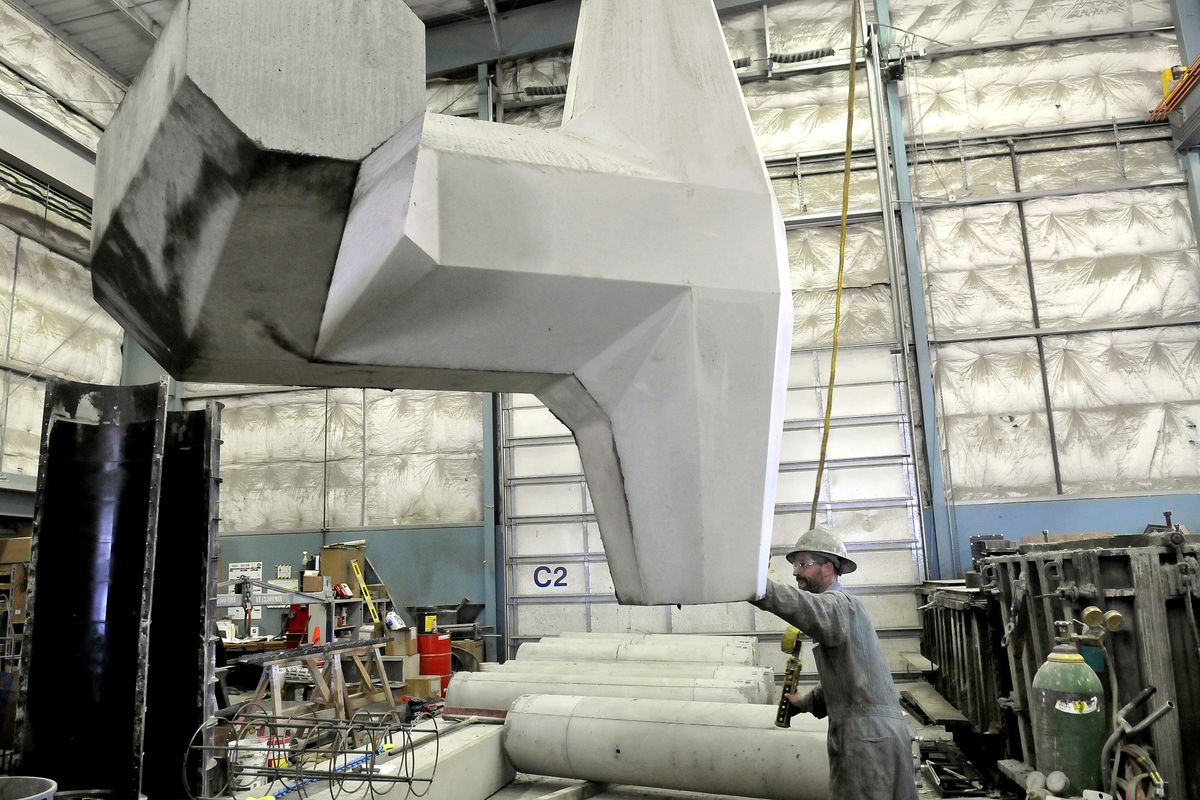Concrete dolos help prevent riverbank erosion and restore fish habitat
Spokane firm makes 140 eight-ton concrete chunks

Visitors to Wilbert Precast Inc.’s production building in northeast Spokane pause when they see several odd-shaped, large concrete objects sitting in a row in the company’s storage yard.
“People are asking us all the time, ‘What are those things?’ ” said Kelli Jenson, a spokeswoman for the privately-owned concrete manufacturing company.
The items are dolos, and Jenson tells people they’re “jacks for giants.” But then she explains that 140 of the 16,000-pound dolos are headed for the Puyallup River in Pierce County, where they’ll be used to halt the erosion of riverbanks.
Dolos have been around for decades but have been rarely seen in the United States. They were introduced in South Africa and are now used around the world, primarily to protect harbors and seawalls from ocean waves. (The origin of “dolo” comes from the word, in South Africa, for oxen knuckle joint.)
Now, in a twist that includes adding tons of loose logs and tree branches on top of interlocking dolos, they’re being used in the Pacific Northwest to prevent washouts of riverbanks and to restore fish habitat.
During the past 20 years, the old-school approach to protecting riverbanks – using deeply buried posts or clusters of large boulders as riprap – has changed. The new approach relies on “engineered logjams,” or ELJs, that are less disruptive to the environment and likely to remain in place longer than other systems.
The key feature of a dolo is the twisted protruding stub that makes it look like a toy jack. That feature helps them lock together, creating a stable base wherever the pieces are placed.
Tim Abbe, who runs Seattle geo-engineering firm Natural Systems Design, is one of the originators of the “dolo timber” design – combining the dolos with heavy logs and loads of branches.
The idea is fairly new. The Puyallup River project, which will use the made-in-Spokane dolos, is just the third example of a dolo timber design, Abbe said.
Biologists believe the dolo timber system creates partly submerged structures where fish and wildlife can hide, while also diverting the stream to protect vegetation and banks from erosion.
It’s also an idea so new that some conservationists are skeptical of the idea of dolo timbers, Abbe said.
“The skeptics say, ‘Oh, no, you can’t put concrete in the river. That’s not right,’ ” Abbe said. “I think those opinions will change. We’re in a sensitive period where people like Pierce County and others are putting their toes in the water and seeing how it goes.”
In a previous dolo timber project along a different section of the Puyallup River, engineers returned after two years and found the concrete pieces had moved a few inches at most, Abbe said.
Making dolos is not a huge source of revenue, but demand for the product is likely to grow over the next decade, Abbe said.
Each dolo shipped to Pierce County generates roughly $1,800 for Wilbert Precast, according to Pierce County’s Public Works Department.
The Puyallup project will cost Pierce County roughly $1 million. Its goal is to prevent the erosion of nearby Orville Road, a key arterial in a rural area of the county.
Public Works Manager Al Amirzehni said engineers predict the road would be washed out within 10 years if nothing is done. The dolo timber project will also create secondary habitat benefits for fish, birds and wildlife, he said.
This is the first dolo project taken on by Wilbert Precast, which produces a wide range of products for various industries. The company makes far larger concrete products than the dolos, said Brock Materne, a production manager for the company.
Materne learned of the project and submitted a bid as a supplier to the general contractor. After Wilbert Precast got the job, Materne spent $20,000 to build a steel form that holds the concrete mix for eight hours as each dolo hardens. Wilbert makes two to three dolos per day and has about 24 more to make.
Amirzehni said the Puyallup project will create about 20 ELJ structures, with six to eight dolos used in each, along with roughly 50 logs or timbers. Some will be along the bank; others will be placed in the middle of the channel to slow down the force of the river during strong runoffs.
Each structure will be about 45 feet long, 15 feet high and 15 feet wide.